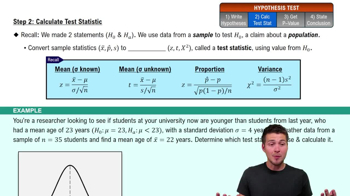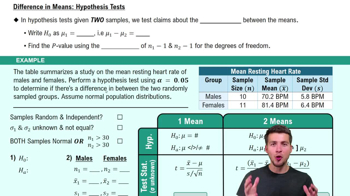Discarded Plastic Data Set 42 “Garbage Weight” includes weights (pounds) of discarded plastic from 62 different households. Those 62 weights have a mean of 1.911 pounds and a standard deviation of 1.065 pounds. We want to use a 0.05 level of significance to test the claim that this sample is from a population with a mean less than 2.000 pounds. Identify the null hypothesis and alternative hypothesis.
Table of contents
- 1. Intro to Stats and Collecting Data1h 14m
- 2. Describing Data with Tables and Graphs1h 55m
- 3. Describing Data Numerically2h 5m
- 4. Probability2h 16m
- 5. Binomial Distribution & Discrete Random Variables3h 6m
- 6. Normal Distribution and Continuous Random Variables2h 11m
- 7. Sampling Distributions & Confidence Intervals: Mean3h 23m
- Sampling Distribution of the Sample Mean and Central Limit Theorem19m
- Distribution of Sample Mean - Excel23m
- Introduction to Confidence Intervals15m
- Confidence Intervals for Population Mean1h 18m
- Determining the Minimum Sample Size Required12m
- Finding Probabilities and T Critical Values - Excel28m
- Confidence Intervals for Population Means - Excel25m
- 8. Sampling Distributions & Confidence Intervals: Proportion1h 12m
- 9. Hypothesis Testing for One Sample3h 29m
- 10. Hypothesis Testing for Two Samples4h 50m
- Two Proportions1h 13m
- Two Proportions Hypothesis Test - Excel28m
- Two Means - Unknown, Unequal Variance1h 3m
- Two Means - Unknown Variances Hypothesis Test - Excel12m
- Two Means - Unknown, Equal Variance15m
- Two Means - Unknown, Equal Variances Hypothesis Test - Excel9m
- Two Means - Known Variance12m
- Two Means - Sigma Known Hypothesis Test - Excel21m
- Two Means - Matched Pairs (Dependent Samples)42m
- Matched Pairs Hypothesis Test - Excel12m
- 11. Correlation1h 6m
- 12. Regression1h 50m
- 13. Chi-Square Tests & Goodness of Fit1h 57m
- 14. ANOVA1h 57m
9. Hypothesis Testing for One Sample
Steps in Hypothesis Testing
Problem 8.CQQ.10
Textbook Question
Robust Explain what is meant by the statements that the t test for a claim about μ is robust, but the (chi)^2 test for a claim about σ is not robust.
 Verified step by step guidance
Verified step by step guidance1
Understand the term 'robust': In statistics, a test is considered robust if it remains valid and reliable even when certain assumptions (like normality of the data) are violated to some extent.
Explain the t-test for a claim about μ: The t-test is used to test hypotheses about the population mean (μ). It assumes that the data is approximately normally distributed, but it is robust because it can still perform well even if the normality assumption is slightly violated, especially with larger sample sizes due to the Central Limit Theorem.
Explain the (chi)^2 test for a claim about σ: The chi-squared test is used to test hypotheses about the population variance (σ²). It assumes that the data is normally distributed. However, it is not robust because even small deviations from normality can significantly affect the validity of the test results.
Compare robustness: The t-test's robustness comes from its reliance on sample means, which are less sensitive to deviations from normality. In contrast, the chi-squared test is highly sensitive to the shape of the data distribution, making it less robust.
Conclude the explanation: The statement highlights that the t-test for μ is more forgiving of assumption violations, while the chi-squared test for σ is not, emphasizing the importance of verifying assumptions before using the chi-squared test.
 Verified video answer for a similar problem:
Verified video answer for a similar problem:This video solution was recommended by our tutors as helpful for the problem above
Video duration:
2mPlay a video:
Was this helpful?
Key Concepts
Here are the essential concepts you must grasp in order to answer the question correctly.
Robustness in Statistical Tests
Robustness refers to the ability of a statistical test to remain valid under violations of its assumptions. A robust test can provide reliable results even when the data does not perfectly meet the conditions required for the test, such as normality or equal variances. This is particularly important in real-world data analysis, where ideal conditions are often not met.
Recommended video:
Guided course

Step 2: Calculate Test Statistic
t-Test for Mean (μ)
The t-test is a statistical method used to determine if there is a significant difference between the means of two groups. It is considered robust because it can still yield valid results even when the data is not normally distributed, especially with larger sample sizes. This flexibility makes the t-test a popular choice in various research scenarios.
Recommended video:
Guided course

Difference in Means: Hypothesis Tests
Chi-Squared Test for Variance (σ)
The chi-squared test is used to assess the goodness of fit or to test hypotheses about the variance of a population. Unlike the t-test, the chi-squared test is not robust; it requires the data to be normally distributed for the results to be valid. If this assumption is violated, the test can produce misleading conclusions, making it less reliable in certain situations.
Recommended video:
Guided course

Step 2: Calculate Test Statistic

 6:21m
6:21mWatch next
Master Step 1: Write Hypotheses with a bite sized video explanation from Patrick
Start learningRelated Videos
Related Practice
Textbook Question
